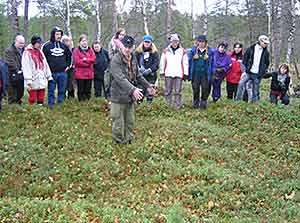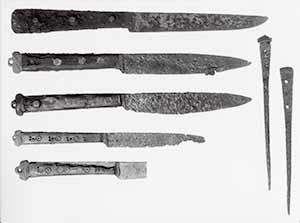The annually migrating Inari Sámi societies began to gather in the winter at the latest during the last half of the 1500s on the western side of the lake at a winter village where social relationships as well as community affairs were attended to.
Popular assemblies were held in the “kota” (Lapp lodge) and decisions concerning community were made. Representatives of external authorities, priests, judges, traders and tax collectors paid visits there as well.
There are twelve winter village sites in Inari which is more than all other Lapland villages put together. They are generally located near small ponds or rivers on sites where several routes to larger bodies of water run. There are isolated winter village sites on the northern side of Juutuajoki River and at Einehjärvi , Pielpäjärvi church and Retsamojärvi lakes. A virtual winter village concentration, eight winter village sites, is located at Nukkumajoki River and one site is close to the mouth of Lapinoja. Winter villages were moved when firewood, pine trees (the bark of which was eaten) and lichen was exhausted, but moving these sites was less common in Finnish Lapland. For example, part of the Nukkumajoki settlements has been inhabited at the same time from the 1500s to the end of the 1600s.
An Easily Recognizable Type of Ancient Remains
The lodge sites of the Nukkumajoki winter village are distinguishable from the rest of the landscape as rectangular, with a raised earthwork about one meter wide and 20-30 centimeters high, all-in-all about 5 x 5 meters. In the center of the earthwork a hearth formation can be clearly seen and there are clearly a door openings in the walls. The remains are from a wooden lodge covered by a roof of peat whose floor was bordered by a six-sided log frame. The upper structure of the lodge, the lodge poles, leaned against the framework, and the framework was supported from above by an earthwork of sand. Peat lodges were solid dwellings which could be lived in during winters for tens of years.
Nukkumajoki 2 – A More Thoroughly Studied Winter Village
The most completely studied of the winter villages of Nukkumajoki is the so-called Nukkumajoki 2 which is located about 100 meters west of the present riverbed, a kilometer from the shore of Lake Inari. There are 13 lodge locations on the site, of which ten have been excavated. A group of finds yielding the best results after many years of excavation was composed of fragmented deer bones; about 500 kilograms were gathered from the site. Some fish and bird bones can be distinguished from the rest of the bone samples. It can thus be assumed that the main source of nourishment for the inhabitants of Inari was deer meat.
 |
 |
Artifacts Portray Life
There have been found 517 objects or pieces thereof at the Nukkumajoki 2 excavation which tell of the buying capacity and the trading connections of the Inari population and possibly even their religious life. Some everyday objects that were found were axes, knives, ferrules, parts of cast iron pots, pieces of lyre-shaped steel and knife blades.
The axes from Nukkamajoki are a Russian sort and some of knife blades are also possibly of eastern origin. Hunting-related articles, large, iron fishhooks, an arrowhead and a lead bullet have been dug up. Old documents relate that the inhabitants of Inari made use of firearms as early as the 1600s, which is confirmed by the lead bullet find. Some of the most exceptional of the imported objects from Nukkumajoki are table (or fruit) knives which were manufactured in central and/or Western Europe. Jewelry finds also depict contacts between the people of Inari with the east and west. A silver Maria-monogram relates to the west and bronze rings to the east. Besides these, tin buttons and a piece of a silver plait have been found.
Not many bone and antler articles from Nukkumajoki have been found, e.g. a shaman’s drum hammer, possibly an arrowhead, a bark knife and spoons have been found. Some of the antler artifacts are typical of the eastern Sámi area, as may be seen from engraved decorations using diamond shapes with dots in the middle. Written sources tell about the inhabitants of Inari going to Varanger to fish. The finding of pumice at the excavations also tells of their travels in the direction of the Arctic Ocean.
Religions Expression in the Village
Among the concentrations of fragmented deer bones on the outside the log lodges the greatest amount of whole objects and arrowhead-shaped copper plate fragments have been found. The plate fragments are similar to finds in Varanger and in the Swedish Sámi region. It has been suggested that they represented money used in trade, but cut into diamond-shaped arrowheads may have some kind of religious significance. The layers of deer bones containing artifacts may be evidence of the sacrifices of community members and of religious life.
From Winter Villages to Winter Cabins
The Nukkumajoki winter villages were inhabited since the second half of the 1500s. Only one dated coin has been found at the Nukkumajoki 2 excavation site: a single kopek coin stamped with the crown prince of Moscow Ivan IV Vasiljevits, later known by the name of Ivan the Terrible. This so-called wire money was minted between 1535-1547, after which it made its way to Nukkumajoki.
The dating of the Nukkumajoki winter village site was done by carbon dating of both the wooden structures of the lodges as well as stoves covered with charcoal and floor surfaces. The most important datings were however taken from deer bones and pieces of antler since lodge structures and firewood evidently come from pine logs of various age. Based on carbon dating and comparison of artifacts, the log lodges of the Nukkumajoki 2 winter village were lived in until the 1660s. The new “Siida”, or Sámi winter village was formed at Pielpajärvi where a church was built in 1646.
Eija Ojanlatva